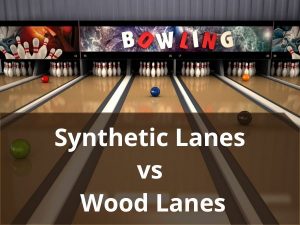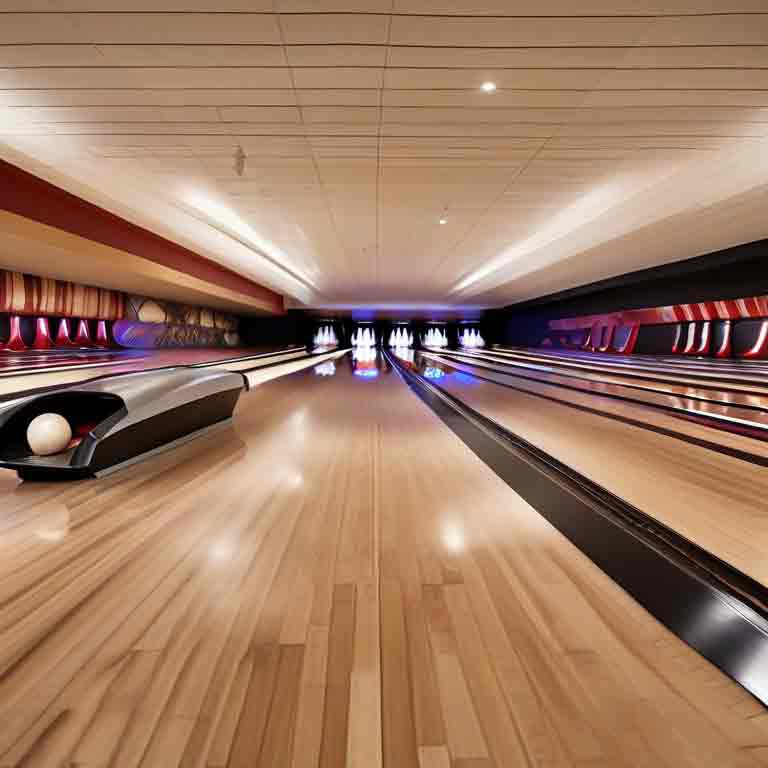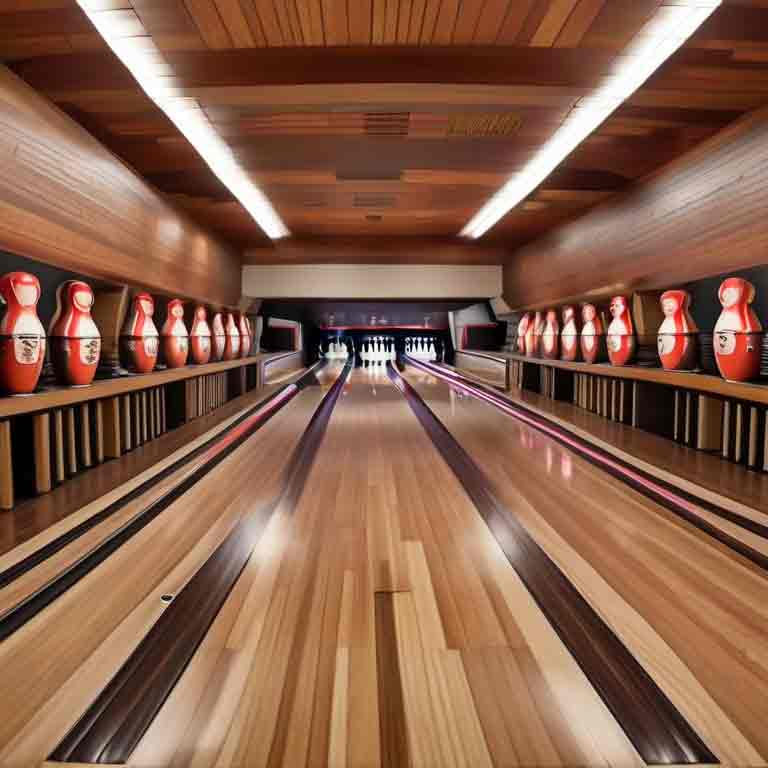Synthetic Bowling Lanes Vs Wood Lanes: Which One Is Best For You In 2024?
Synthetic Bowling Lanes Vs Wood Lanes! If you have been bowling for a while now, you have probably heard about synthetic lanes and might have played on them as well. Did you ever wonder if these synthetic lanes are any different than typical wood lanes? While some bowling alleys have completely changed their lanes to modern synthetics, some still have old-school wooden lanes.
Today, I am here to differentiate these two types of lanes and give you an overall analysis of the synthetic bowling lane. The battle of synthetic bowling lanes vs wood lanes has been going on for quite some time. So let’s settle that down, shall we?
Also Read:
2. What You need to Know about Bowling Lane Arrows and Dots
3. Bowling Lane Installation Guide

Main Differences between synthetic bowling lanes and wood lanes
Looks can be deceiving. The synthetic and wood lanes may look similar, but they are completely different.
If you put the same lane conditioner in both of these lane surfaces, the result will be significantly different as it will play differently. Because wooden lanes are softer, they tend to be less durable whereas synthetic lanes are harder, so they will last for a long time. Wooden lanes easily get wear, tear, and scratches. But the synthetic lanes are resistant to them.
Another notable difference between these two lanes is that wood lanes are porous and absorb oil more than synthetic lanes. Synthetic lanes hardly absorb any oil. Compared to synthetic lanes, wooden lanes don’t allow bowling balls to skid farther down the lane. Plus, synthetic lanes have a more powerful backend reaction that wood lanes lack.
What are synthetic bowling lanes?
Bowling lanes that are much more durable than wood lanes and resistant to wear, tear, scratches, and cracks are called synthetic bowling lanes. It has no organic component like wood in it. Hence, they are called synthetic. In most bowling alleys, wood lanes are now being replaced with low-maintenance synthetic lanes because of being stronger and ensure better backend reaction. That is legit every bowler’s dream.

Credit: probowlingtips.com
What are wood bowling lanes?
As the name suggests, wood lanes are made of wood. Pinewood and maple wood are the most common types of wood used by bowling lane manufacturers. Wooden lanes have characteristics that are quite opposite to synthetic lanes. They are very prone to wear and tear and are very high maintenance. Because it has organic components in it, bowling alleys with wood lanes are always extra careful when it comes to looking after them. Because wood is porous, the lane conditioner gets absorbed into it pretty easily. And so, on wooden lanes, the oil is reapplied more frequently. Due to chemical construction, wood is softer. That’s why it is less durable and often requires repairing.

What are synthetic bowling lanes made of?
Before American Bowling Congress was founded, there weren’t many strict rules regarding bowling lane dimensions. There weren’t even any specifications about the materials of those bowling lanes. At that time, wood was the most accessible material and cheaper, well because we had a lot more trees and greenery than we have now.
After American Bowling Congress was established, the wooden bowling lanes were coated with shellac on which bowlers used to play with bowling balls made of lithium. But because shellac is pretty harmful to your health, it was later replaced with lacquer. Decades later, most probably after the 1990s, urethane became a big deal in the bowling industry. Besides manufacturing urethane bowling balls, people started to use urethane coating on the bowling lanes for advanced durability.
After the 1990s, synthetic lanes got all the attention as they became commonplace for every bowler. Except for a few veteran bowlers who still prefer wood lanes over synthetics, most bowlers love what synthetic lanes offer. The long-lasting surfaces with tremendous backend reaction, easy to clean and control, and less need for maintenance— all of these traits are truly appreciated.
Different bowling lane manufacturers use different materials to construct their signature synthetic bowling lane frames. Some companies offer multiple choices for people to choose from as they produce lanes in different materials. Generally, synthetic bowling lanes are made from a combination of synthetic materials like the matrix of melamine resin and resistant aluminum oxide. The resin is mainly used to toughen up the upper layer of the synthetic lanes. It also ensures a smooth finish and a firm texture at the same time.
Are synthetic bowling lanes oiled?
Like any other bowling lanes in the world, synthetic lanes are also oiled. It can have various kinds of oils on it. The oil application machine can be programmed to apply either a particular kind of oil or a mixture of two kinds of oil. The oil ratio is also an important factor that matters in terms of the bowling lanes’ performance. Every bowler loves synthetic lanes because the oil doesn’t get absorbed at all.
Typically, the synthetic bowling lanes have a layer of resin that makes the lane surface almost non-porous. Any oil you see go missing is because of your bowling ball surface. Bowling ball is a bit more porous than synthetic bowling lanes. And that’s why you see some leftover oils (where the ball didn’t roll) even after an entire game.
FAQs Of Synthetic Bowling Lanes Vs Wood Lanes!
What are the main differences between synthetic and wood bowling lanes?
- Synthetic lanes are made of high-density fiberboard or phenolic resin, offering a more consistent and durable playing surface. Wood lanes, traditionally made from maple and pine, offer a classic feel but require more maintenance and can show wear over time.
How does the ball react differently on synthetic lanes compared to wood lanes?
- Balls tend to slide more on synthetic surfaces due to their smoother finish, which can affect hook potential. On wood lanes, the natural grain and wear patterns can create more friction, impacting ball trajectory and hook.
Are synthetic lanes better than wood lanes?
- “Better” is subjective and depends on what the bowler prefers. Synthetic lanes offer consistency and durability, making them a popular choice in modern bowling alleys. Wood lanes appeal to traditionalists and those who enjoy mastering the variations in the lane’s surface.
Do professional tournaments prefer synthetic or wood lanes?
- Many professional tournaments and leagues have shifted to synthetic lanes due to their durability and consistent conditions, reducing the variability in play across different venues. However, some traditional tournaments still use wood lanes to preserve the classic bowling challenge.
How do maintenance requirements compare between synthetic and wood lanes?
- Wood lanes require regular sanding, sealing, and oiling to maintain their condition, making them more labor-intensive and costly to upkeep. Synthetic lanes are easier to maintain, requiring less frequent resurfacing and providing greater resistance to wear and tear.
Conclusion
So how long have you been bowling? When did your curiosity make you wonder about synthetic bowling lanes? There are many differences you will feel when playing on all types of Bowling Lanes. To understand the differences between these two types of bowling lanes better, you should give wood lanes a try, at least one.
There are still some traditional bowling centers where you can play on wood lanes. It is always interesting to know about the stuff you are involved with. If you think you won’t be able to play on a wood lane, that’s okay. I would want you to focus on the information I have provided. If you are already playing on synthetic lanes, stick to that! Good luck and have fun, my friends!

Passionate Bowler and Bowling Enthusiast
Jess Pinelli is a dedicated bowling enthusiast with a deep love for the sport that spans over 6 years. With numerous strikes, spares, and a few gutter balls under hes belt, he has honed his skills on lanes across the country. Pinelli’s journey in the world of bowling has been a remarkable one, from casual weekend games with friends to competitive league play and even a few local tournaments.
Driven by her passion for the game, Pinelli decided to channel her expertise and knowledge into the digital realm, becoming a prolific author on this bowling website. She’s your go-to source for everything bowling-related, from mastering the perfect hook to choosing the right bowling ball and even navigating the world of bowling etiquette.
When she’s not busy writing informative articles or reviewing the latest bowling gear, you’ll likely find Pinellis at her favorite local bowling alley, helping newcomers improve their game or enjoying some friendly competition with fellow bowlers. She firmly believes that bowling is not just a game but a community, and she’s committed to fostering that sense of camaraderie both online and offline.

